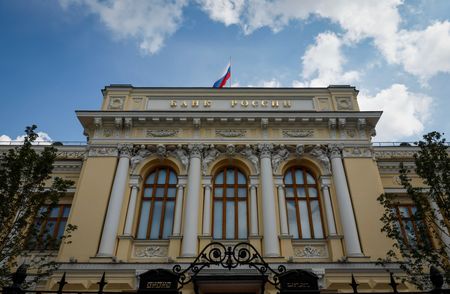By Elena Fabrichnaya, Alexander Marrow and Vladimir Soldatkin
MOSCOW (Reuters) -Inflation is set to ease more slowly than previously thought, Russia’s central bank said on Friday as it held its key interest rate at 16% for the third meeting running and acknowledged for the first time that inflation may not fall to its 4% target this year.
The decision was in line with a Reuters poll of economists, which had forecast that the persistence of inflation, fanned by strong consumer demand and widespread labour shortages, would prevent the central bank from easing borrowing costs more quickly.
The bank lifted its inflation forecast to 4.3-4.8% from 4-4.5% previously.
“Due to the remaining elevated domestic demand, which outstrips the capabilities to expand supply, inflation will return to the target somewhat more slowly than the Bank of Russia forecast in February,” the bank said in a statement.
The Bank of Russia had raised rates by 850 basis points in the second half of 2023, including an unscheduled emergency hike in August as the rouble tumbled past 100 to the dollar and the Kremlin called for tighter monetary policy.
Inflation, the bank’s main area of concern, stood at 7.4% in 2023, compared with 11.9% in 2022. Economists expect it to end 2024 above 5%.
Governor Elvira Nabiullina outlined different scenarios the bank has considered, expecting the gap between supply and demand to gradually narrow, bringing inflation close to target by year-end.
“If disinflation is too slow, we do not exclude maintaining the current key rate until the end of the year,” Nabiullina said, adding that a rate raise was possible if disinflation stops.
IMPROVED GDP PROSPECTS
The bank updated its macroeconomic forecasts, raising Russia’s economic growth prospects to 2.5-3.5% from the previous range of 1-2%. It increased its forecast for the average key rate range in 2024 to 15-16% from 13.5-15.5%.
“The big hawkish surprise was the upward revision to its average key policy rate forecast,” said Nicholas Far, Emerging Europe Economist at Capital Economics. “That implies the CBR now envisages much less scope for monetary easing in the second half of this year.”
Russia’s economy rebounded sharply last year from a slump in 2022, but the growth relies heavily on state-funded arms and ammunition production and masks other problems.
“Labour shortages come as the key constraint on the expansion of output of goods and services,” the bank said. “Concurrently, labour market tightness continues to increase.”
The bank’s improved GDP forecast mirrors that of the economy ministry, which now expects economic growth at 2.8% this year, while envisaging a weaker rouble and shrinking current account surplus in the coming years. The ministry’s stress scenarios anticipate stalling growth and a diving rouble.
The central bank raised its 2024 current account surplus forecast to $50 billion from $42 billion previously.
In the first half of 2023, the central bank had cut rates as low as 7.5%, gradually reversing an emergency hike to 20% implemented in February 2022 after Moscow sent its army into Ukraine, triggering sweeping Western sanctions.
The bank’s next rate-setting meeting is scheduled for June 7.
(Reporting by Alexander Marrow in London, Elena Fabrichnaya and Vladimir Soldatkin in Moscow; Editing by Mark Trevelyan and Toby Chopra)





